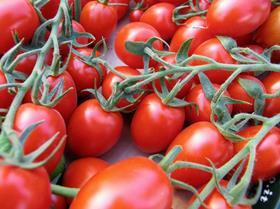
With penetration at 92 per cent, it would seem there is only so much scope for the tomato category to grow further, but several key players are hopeful of doing just that.
The trend for premiumisation is adding incremental growth to the sector, with premium products such as cherry and plum tomatoes on the vine growing in popularity. “We’re seeing premium ranges move to the ‘on the vine’ pack format to reinforce the message of freshness and to offer additional green notes to the aroma,” says Thanet Earth’s marketing manager Steve Hatt. “Premium tomatoes are enjoying good growth and this should only increase with the build-up to Christmas and people tending to buy premium over the festive period.”
Cherry on the vine and Piccolo are delivering the biggest year-on-year sales growth, with most NPD focused on the premium tier. “This is one way in which we could encourage shoppers to trade up,” says Hatt. In addition, there has been an explosion of colour on supermarket shelves, with most retailers now listing mixed packs of smaller tomatoes.
“I think the premium market can continue to grow,” agrees David Shepherd of Evesham Vale Growers, who says top-tier tomatoes are “driving the market”. “It makes up over 60 per cent of the market; a few years back it was 50 per cent; and it won’t be long before it’s well over 70 per cent.”
This growth in the top tier has helped the tomato market grow in value by 5.4 per cent in the 52 weeks to 8 October, [Kantar Worldpanel], although this is partly due to price inflation caused by the rising cost of imports. As Brexit bites, retailers are tending to favour British-grown produce to avoid these costs and UK growers are stepping up their production as southern European sourcing makes way for increased northern European production under lights.
“Imports are becoming unsustainably expensive with the British retail supplier taking the strain of that price increase more often than not,” explains Phil Morley of the Tomato Growers’ Association. “There is a general impetus from retailers to favour British where possible, but price is still an issue, with consumers still wanting the best quality with very little return to producers who are faced with increased costs, partly caused by the weak pound.”
This year, unfortunately, British production was hampered by low light levels, with yields down compared to 2016, according to Evesham Vale Growers. With the season still running, the jury is out, but poor weather in July and August is likely to limit volumes. Despite this, Morley insists that the fruit has been “of exceptional quality relative to imports”.
These difficult growing conditions are part of the explanation for a drop-off in promotions this season, says Morley, with fewer needed to shift excess stocks. But Hatt says the fall in offers reflects a change in shoppers’ priorities. “It’s all about more frequent, more targeted, smaller shopping trips these days,” he says. “We’ve seen promotions like two-for-one fall away further each year. It’s much more about everyday better value pricing now.”
As far as sales go, the potential for growth is great, Morley says, with the UK among the lowest consumers of tomatoes in the EU: “The maths is pretty simple. Just another couple of portions of tomatoes per month would make a huge difference to demand.”
When it comes to Brexit, delegates of the recent Tomato Conference in Kenilworth were told there were three possible wholesale price increases for tomatoes once the UK leaves the EU: a five per cent rise (if the UK succeeds in gaining a FTA with the EU); an eight per cent increase (if there are no UK import tariffs but no FTA); or an 20 per cent hike (if there is no FTA and all existing WTO tariffs are adopted).
AHDB head of strategic insight David Swales also predicted that labour costs in the produce industry could rise by up to 50 per cent after Brexit if businesses have to incentivise workers from other industries.



